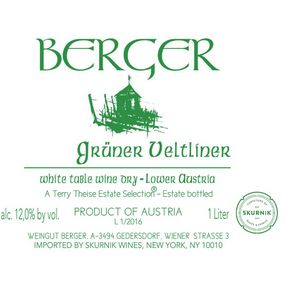Scribe Rosé of Pinot Noir Pet-Nat
Fond Croze Cairanne
Ziereisen Gutedel
Berger Gruner Veltliner
SAINT-ROCH CÔTES DU PROVENCE ROSÉ
Reciente Rioja
due terre Nero d’avola
La grande clotte Bordeaux
Domaine FL Savennières La Croix Picot
Ramituelle Tibouren Rosé
Ca’ Gialla Barolo
Turley Zinfandel Juveniles
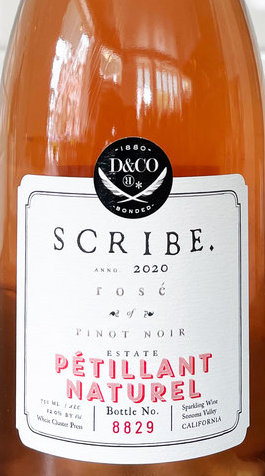 Scribe pét-nat rosé of pinot noir – organic
Scribe pét-nat rosé of pinot noir – organic
The Scribe Winery tale begins with a charming young entrepreneur named Andrew Mariani and a storied piece of land—home, most recently, to a turkey farm—located about three miles east of the Sonoma town square. A mile-long driveway lined with palm trees leads to a decrepit hacienda built a century ago by two bootlegger brothers from Germany. Acres and acres of brush and cactus surround impeccably trellised grapevines. In the distance are vast expanses of a conserved mountainside, where foxes and mountain lions roam beneath California bay laurel, oak, and madrone trees.
Scribe founder Andrew Mariani and his brother Adam grew up in a farming family in the Santa Clara Valley. Andrew and Adam see themselves as scribes of their land, and the Scribe winery is the result of their labor. One of their primary goals is to help revive their property while making sure not to overpower nature’s patterns in the process. This goal is embodied in what they call “Forever Wild Farming,” which works to integrate their harvest into the existing ecosystem of the land. Together with winemakers Kristof Anderson (Nils Venge’s protegé) and Andrew Avellar, the Mariani brothers have chosen to ban the use of chemicals on the property, and instead, solely participate in natural methods of vinification. The team works to increase the biodiversity of their land by encouraging natural species to thrive alongside the vines. Andrew reiterates that the outcome of these choices includes wines that are faithful representations of their origins and a sustainable model that enriches rather than depletes the land.
In 1858, the son of a famous German champagne producer named Emil Dresel purchased the land and started a vineyard with cuttings he had smuggled into the country on his maiden voyage in 1849. Amongst these plants were the first Riesling and Sylvaner varieties imported to the United States. His brother Julius joined him in 1869 and the outspoken duo was known to be fervent abolitionists, aggressive gamblers, occasional outlaws, and viticultural pioneers. Flamboyant behavior aside, the vineyard was a great success and in 1904, under the eye of Julius’ son Carl, Dresel wines received first place in the red and white wine categories at the World’s Fair.
After years of success, the winery crumbled in 1920 with the enactment of Prohibition. The family burned the Dresel Wine Co. bond in protest but the hacienda continued to serve up tasty beverages and rowdy good times. With the help of the San Francisco police force, the property served as a byline for bootleggers to transport their goods, as well as a password-protected speakeasy. On a dark night, one need only whisper, “Julius sent me” at the building’s back entrance. Inside, you’d find a maze of whiskey, music, wine, and for the right price, a young lady to show you upstairs, where the hacienda ran an altogether different business.
Winery Notes: As we welcome spring, we’re excited to share with you our 2021 Pétillant Naturel rosé wine. Crafted using the ancestral method, these wines are bottled before primary fermentation is finished – without the addition of secondary yeasts or sugars. The wine completes the fermentation process in the bottle, capturing Co2 and resulting in a lively, rustic, terroir-driven sparkling SCRIBE wine.
Grapes were harvested from Scribe’s Brooklime Vineyard, which sits on the Sonoma Mountain ridge line at about 1,500 ft elevation, overlooking the city of Petaluma to the west and Sonoma to the east. It typically sits above the fog line so mornings and afternoons can come with plenty of sunlight, though evenings are cool. Planted to clones 667 and 777, the vineyard sits on a steep grade, on Guenoc clay-loam soils.
Vinification: Hand-harvested Pinot Noir was foot tread to release juice and allow for skin contact and color pickup. The juice was whole cluster pressed and settled for 24 hours prior to being racked off its gross lees. The wine was fermented at 50 F in a stainless-steel tank and was bottled on October 13th with 18g/L of residual sugar. Fermentation finished in bottle over the following weeks. No dosage or disgorging.
Tasting Notes: Aromas of hibiscus, guava, and white tea.
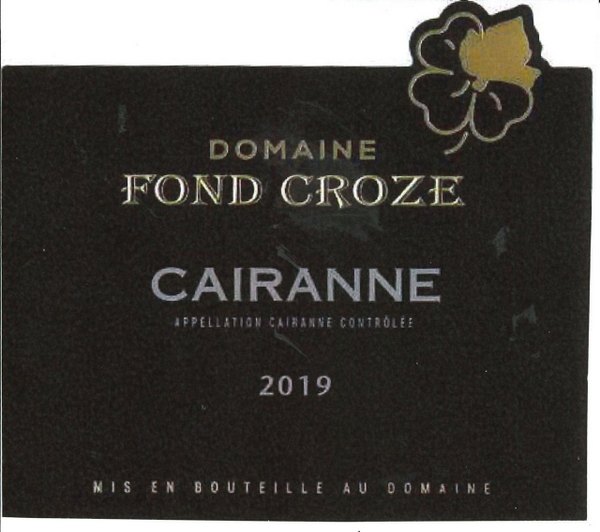 Fond croze cairanne – organic
Fond croze cairanne – organic
Cairanne is a village in the Côtes-du-Rhône appellation, one that due to its high wine quality, is allowed to put the name of the village on the label (like Gigondas, Lirac, Vacqueyras, etc.).
Domaine Fond Croze is located on the outskirts of the town of Cairanne, and this family-run business converted to organic viticulture in the nineties.
Founding patriarch Charles Long first purchased land outside Saint Roman de Malegarde after returning from World War I. His son, Raymond, expanded the vineyards once he started full-time in the business and today, Raymond’s sons Bruno (the winemaker) and Daniel (the vineyard manager) are the 3rd generation. Daniel’s son Guillaume continues the tradition, armed with a degree in enology and viticulture, and some impressive stints at wineries in the US.
The Longs produce a wide range of honest and unpretentious wines from their 200 acres of typical Rhône-ish varietals, distributed among six appellations: Cairanne, Rasteau, Côtes du Rhône Villages Vaison la Romaine, Côtes du Rhône Villages, Côtes du Rhône and I.G.P. Méditerranée, planted to nine different grapes, red and white.
60% Grenache Noir, 20% Carignan, and 20% Mourvèdre from old vines planted on clay-limestone soils on their five-acre estate hillside vineyard in Cairanne.
This wine has a deep garnet color with purplish hues. The first nose is complex and after slight aeration it releases aromas of stewed small black fruits and candied cherry. On the palate, we detect a nice acidity with well-present and structured tannins. This wine offers aromas of black fruits as well as toasted notes on the finish. Complex and well balanced, the finish is long.
90-93 points, Robert Parker’s Wine Advocate: Half Grenache, with the balance split equally between Carignan and Mourvèdre, the 2019 Cairanne is dark and impenetrable in the glass, giving up just brooding aromas of blackberries and dark-skinned plums. It’s full-bodied and tannic at this stage, but the tannins are ripe, adding plush layers of textural interest and lingering gently on the finish.
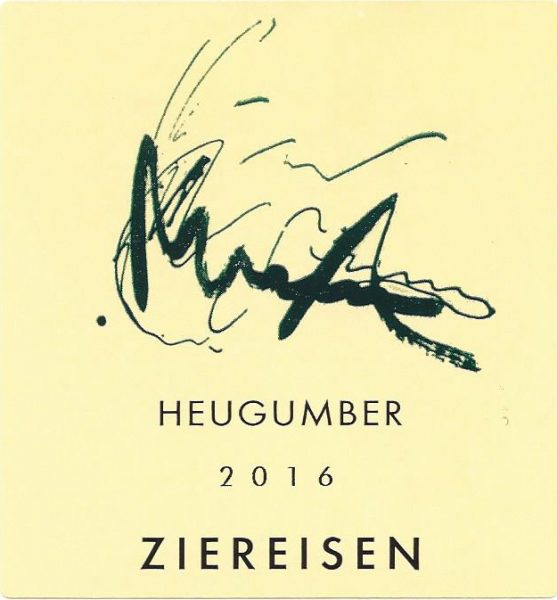 Ziereisen gutedel – Organic
Ziereisen gutedel – Organic
Ziereisen is located in the very southern part of Baden in a town called Efringen-Kirchen, directly on the Rhine river at the border of Alsace and Switzerland. The area is called Markgräflerland; another name is the Dreiländereck – the “three-country corner”: Basel, Switzerland is the closest city, just nine miles south.
Here, Hanspeter and his wife Edel produce outstanding Pinot Noir and Gutedel (called Chasselas in France and Fendant in Switzerland) as well as a bit of Syrah, Chardonnay, Pinot Gris, and Blanc. One hears the same mantra in this domain that we hear in all of the top estates: “Quality is made in the vineyard. We work with utmost care to create the conditions for high-class wines. In the cellar, we only do the minimum of work necessary allowing the wines to rest and time to mature. The French swear by their terroir – in this respect I am a Frenchman.” Says Hanspeter Ziereisen
“Our philosophy is that wines should reflect their provenance as purely as possible. This is why we treat our vines and wines with great care by minimizing chemical treatments and filtration. In the vineyards, we try to make use of the traditions that our ancestors passed along to us. We produce muscular wines. Not sumo wrestlers but decathletes; smooth, elegant, strong, and athletic. Strength and balance is our target. We aim to achieve a balance between acidity, tannin, alcohol, and aroma. Recipe winemaking is a horror for us. Individuality is the signature of Ziereisen.”
Chemical fertilizers and sprays are strictly avoided in the vineyard, though this estate is not certified organic. Work in these south-facing vineyards is of paramount importance. “Handcrafted work is not exceptional for the Ziereisen family, it is standard.” writes Hanspeter. After an initial selection in the vineyard, grapes are sorted again in the cellar.
Following this rigorous selection, the fruit is fermented spontaneously in large barrels and left on the lees for 19 months. The Heugumber bottling, their entry-level (Heugumber means grasshopper in German) though it’s hardly “basic” with 19 months on the fine lees.
Wine writer Terry Theise: “If you drive there, you keep going south south south until you can see the border to Switzerland, and that’s where you find Ziereisen. Look west over the Rhine valley and the Vosges have faded off to the north. A big undulating hill looms over Ziereisen’s village, and if you climb high enough upon it you are looking at the city of Basel resting in its furrow between the hills. The northernmost slopes of the Swiss Jura are behind it, and Hanspeter Ziereisen swears that “On a clear morning you can see the Berner Oberland,” with its peaks like great white giants, as if bride’s veils were rippling on the horizon. Beaune is closer than Stuttgart. To the extent Baden means anything at all to American lovers of German wine, it’s either the big names (and their big reds) from the Kaiserstuhl or perhaps the tangy volcanic whites from the impossibly gorgeous Ortenau.”
“But down here where “the buses don’t run” (in Hunter S. Thompson’s coinage) (Or was it George Carlin? Either way….) Mr. Ziereisen is creating a fine rebellion. He is also part of a group of like-minded producers who wish to wriggle free of the strait jackets of the German wine law, and simply make the best wine they can. Meeting Hanspeter for the first time, his first words were “What you need to know about me is, everything I do is forbidden.” Then we should get along just fine, I thought.”
“Hanspeter’s whites seem to look to the Jura for their paradigms, and I have sometimes thought that they’d be among the best in the Jura, were they in fact located there. This wine, seriously, is just stupid-good, and I happen to know we can all afford it and that every restaurant on earth should be pouring it. The leesy savor is addictive, the walnut-oil umami will make a slave of you, the buoyancy will have you gulping the bottle down in record time. The finish is a gorgeously weird amalgam of ginger and hay and phyllo. Even their basic level of Gutedel is only bottled after 19 months in cask on the lees. Clearly these people are nuts. I tasted the 2018 a few months ago; it was kind of them to send the new vintage. In common with most of Hanspeter’s whites, it’s decidedly leesy and shows a more or less vivid flor note. But while the bigger Gutedels are greater in effect, this one is content to be its nutty irresistible self, giving you an entirety of vinous delight with all of 11% alc. Look, I love Gutedel (Chasselas) and I’ve hardly ever had one that wasn’t delectable, bearing in mind I haven’t had them randomly but rather from good growers who resisted the tendency for the wines to be attractive but mundane. This wine is anything but mundane, though it strikes me as a teeny bit more slight than was the ’18. But what a useless cavil that is! If I ever went to a restaurant that poured this by the glass, I’d never go to any other restaurant.”
BERGER GRUNER VELTLINER (ORGANIC)
Weingut Berger is in the eastern part of the Kremstal, in the town of Gedersdorf. With Erich Berger’s guidance, the winery has implemented methods to produce wines that focus on varietal character and terroir. The white wines grow on steep loess terraces that characterize the landscape of the eastern part of the Kremstal. These terraces store heat during the day and reflect it onto the vines at night producing wines with unique fruity, fresh, and bright flavors.
The red wines are grown at the top of the hills where more humus-rich soils dominate and give the wines length, body, spice, and lush fruit. Vineyards are maintained according to the latest organic guidelines. In the winery, efforts are made to preserve the fruit character by using cultured yeast in combinations with slow fermentations that are temperature controlled. The white wines are then aged exclusively in stainless steel, while the red wines are matured in traditional oak vats.
Erich’s liter bottling of Grüner Veltliner has steadily improved over the last decade. It’s a perfect foil for the infectious drinkability that this variety is known for but has an extra level of clarity and complexity that is sometimes missing from this category. Fermented entirely in stainless steel from estate-grown, Loess-dominated vineyards in the Kremstal. Fresh and expressive, with citrus, floral and mineral flavors that linger in the mouth. It practically invites you to have a second glass. A very pretty fragrance and the palate is remarkably salty and expressive, with an extra level of clarity and complexity that is sometimes missing from this category.
Dry, zingy, crisp, and clean with pure, frisky green fruit flavors of lime, melon, and pear, this is a terrific alternative for Sauvignon Blanc and Pinot Grigio lovers. Sealed with a screwcap in the handy liter bottle, this pairs well with white fish, chicken and veggies, especially asparagus, string beans, artichokes, and Brussels sprouts, or veggie pâté, hummus, cheese & spring onion crackers.
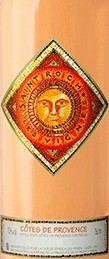 SAINT-ROCH CÔTES DU PROVENCE ROSÉ – Organic
SAINT-ROCH CÔTES DU PROVENCE ROSÉ – Organic
Saint Roch les Vignes is not an individual domain, but rather a modern cooperative production facility in Cuers serving most of the family winegrowers in that small hillside village, as well as those of neighboring Puget-Ville and Pierrefeu northeast of Toulon. Built in 1911 with the combined effort and assets of 143 growers, the winery was upgraded with state-of-the-art equipment in recent years and now handles vinification for more than 200 local vignerons.
The wines of Saint Roch are held to a higher standard than normal French cooperative wineries, as growers must not only adhere to Appellation Controlee laws, but also meet the quality standards of the Maitres Vignerons de Saint Tropez, who oversee Saint Roch‘s international sales and marketing. This group consists of seven highly-regarded, limited production Cotes de Provence domains headed by Edgar Pascaud, proprietor and director of Château de Pampelonne.
All fruit is destemmed. Direct pneumatic press juice. Short maceration on skins to attain Provence’s signature pale pink color. Fermentation takes place in temperature-controlled stainless steel tanks. No malo-lactic. Brief élevage on the lees in temp-controlled inox tanks before being filtered with diatomaceous earth and bottled in January after harvest.
This blend of Cinsault (50%) and Grenache (50%) has everything a Provencal rose should: delicacy, dryness, and drinkability! It smells of bright red berries, and the palate is lively and full of crisp, food-friendly acidity. Drink chilled, of course, with fish dishes. The Saint Roch les Vignes Côtes de Provence Rosé is France’s quintessential quaffer. This excellent import value is the perfect wine to share in the shade. Brisk, with a nice finish, a perfect porch pounder.
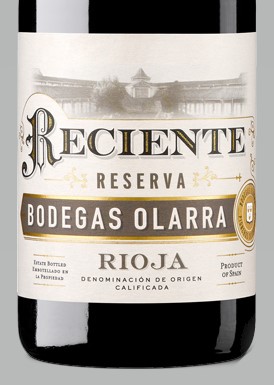 Bodegas Olarra Reciente Rioja Reserva – sustainable
Bodegas Olarra Reciente Rioja Reserva – sustainable
Bodegas Olarra is located on the outskirts of Logroño, in the heart of the Rioja Qualified Designation of Origin, and within the highly regarded sub-area of Rioja Alta. Since its establishment in 1973, Olarra has been noted for the beauty and complexity of its unique premises thanks to its Y-shaped ground plan and its 111 hexagonal domes. Bodegas Olarra is commonly known as the Cathedral of Rioja. This winery tastefully merges cutting-edge wine-related technologies with the traditional winemaking methods of La Rioja, and as a result, it creates wines with the strictest parameters of quality.
The 2017 Reciente Rioja Reserva, made from 90% Tempranillo with 10% Mazuelo (Carignan) and Graciano, was aged for 16 months in French and American barriques, followed by 20 months in bottle to seamlessly integrate the aromas and flavors.
Today, all the gorgeous spice, leather, and toasted-coconut notes of a great Reserva are deepening. It’s drinking perfectly now, but will stand up in the cellar for years
Fresh and lively, this delicate Rioja delivers flavors of black currants and blueberries in a minor key. The fruit is soft and sweet, while the acidity has a crisp apple edge, giving the wine a plaintive voice, “like a sad love song,” one taster said. The flavors are lasting, ready to pour with roast goat. 91 points. (reviewed at $28)” – Wine & Spirits
“Dark ruby. Ripe red and dark berries, cola, candied licorice and a floral nuance on the perfumed nose. Fleshy red fruit preserve, mocha, vanilla and spicecake flavors spread out steadily though the midpalate, showing good depth and supple texture. Velvety tannins build on a supple, warm finish that echoes the ripe red fruit and floral notes. 91 points.” -Vinous
“Aromas of cardamom and other baking spices blend with peppercorn and blueberry accents to form a unique nose. On the full-bodied palate, flavors of berries and toast carry to the finish. 90 points. (reviewed at $28).” – Wine Enthusiast
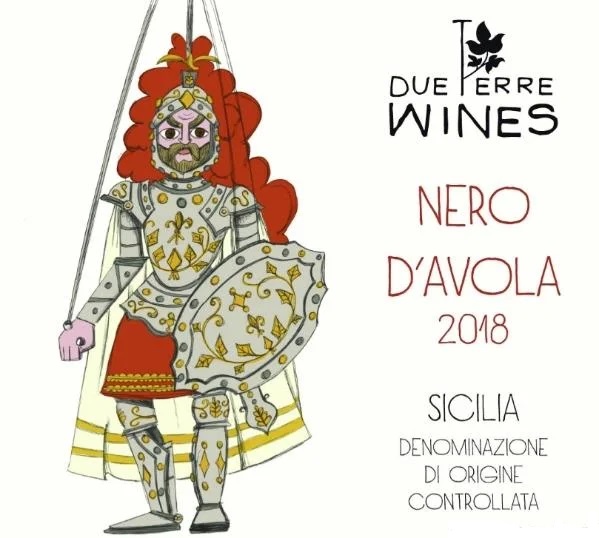 Due Terre nero d’avola (Organic, Biodynamic, following Natural practices)
Due Terre nero d’avola (Organic, Biodynamic, following Natural practices)
This super fresh, certified organic Sicilian bottling is made of 100% Nero d’Avola, one of Sicily’s signature grape varieties. Grown at a very high elevation, this is a crisp, crunchy, vivid expression of Nero d’Avola that shows exceptional purity and chalky minerality. Expect a bright purple, floral palate full of lush boysenberry and blueberry fruit. The grapes undergo a 24 hour maceration at low temperatures to preserve freshness and aromatics. Fermented in stainless steel and aged in concrete tanks for eight months. Plump and juicy. Loads of red and black fruits, licorice, tobacco, and dried flowers. It’s like Cab and Syrah had a love child. Some Neros can be big and bold, but this version is all about purity and freshness.
Winery notes:
“Due Terre Wines is a collaborative effort between friends and we are happy to present our first line of wines made from the indigenous grapes of Italy – delicious, economical, well packaged, and certified organic. All the wines are produced as 100% pure varietals with minimal intervention and winemaking in order to allow the characteristics of the grape to shine through. There could not have been a better place than Sicily to produce these first wines for our project – the island has the largest number of organic vineyards in Italy and produces more grapes of quality than have a home in IGT and DOC bottlings and is often sold off as bulk wine to the north. We cannot bear to think of these delicious native grapes disappearing into another anonymous bottle and are very happy to give them a home at Due Terre Wine.”
“We chose to use drawings of the traditional marionettes used in Orlando Furioso and other plays in the Opera dei Pupi (the roots of which stretch back to at least the 15th century). Puppets and marionettes were a popular form of entertainment throughout Medieval Europe for all classes of people and it is probable that the earliest performances involved local history and folklore and with each new conqueror of the island, a new group of people would leave their own cultural stamp upon the emerging folk tradition. In Sicily, this form of entertainment uses wooden marionettes on strings and metal wires instead of hand puppets made of cloth. Although the tradition is becoming less common, the Opera dei Pupi has not died out completely and there are now actions being taken to preserve this unique folk-art. UNESCO has designated Sicilian Puppet Theatre as part of humanity’s “oral and intangible heritage” and has devised a plan to save it from extinction. We hope that by bringing them to our wine labels we can help in some way to preserve this tradition.”
 La Grande Clotte Lussac-Saint Emilion Rouge – Sustainable
La Grande Clotte Lussac-Saint Emilion Rouge – Sustainable
In the 1990’s, Château La Grande Clotte was rented to Michel and Danny Rolland. Since 2016, it’s been the property of Julie and Mathieu Mercier, a young couple of oenologists from Bordeaux. The vineyard of the domain is in one piece of land, located on a clay and limestone soil typical of the Lussac Saint-Emilion appellation. 20 acres are dedicated to growing red wine grapes which receive all the attention and care they deserve from the vineyard to the cellar in order to produce a high-quality wine that reflects the savoir-faire and environmental care of the region.
90% Merlot and 10% Cabernet Franc on vines that are approximately 25 years old. Tank vinified and finished in tank and barrique for about a year.
Decanter: Bright, bold, perfumed, and softly sweet blackcurrant notes on the nose. The palate has pleasing initial juiciness to it but chalky tannins are still at the fore with the fruit aspects having spiced edges presently. Licorice, cloves, mint, and a nice wet stone, mineral aspect all combine to add interest, spice, and freshness.
91 points, James Suckling: A solid and fruity red with chewy tannins and lots of fruit. Medium to full-bodied, it has a velvety texture with just enough freshness and an earthy finish. Extremely well done for this appellation. 90% Merlot, 10% Cabernet Franc.
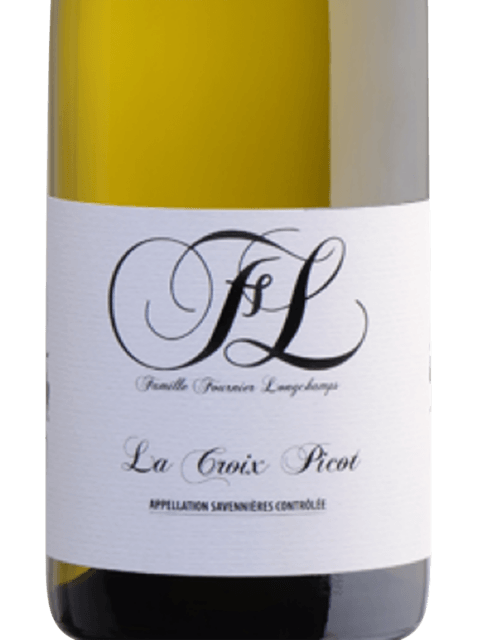 fournier-longchamp DOMAINE FL SAVENNIÈRES La Croix Picot 2018 – organic and biodynamic
fournier-longchamp DOMAINE FL SAVENNIÈRES La Croix Picot 2018 – organic and biodynamic
Loire Chenin Blanc is often overlooked in many wine circles. Sweet or dry, it can offer profound, honeyed depth, and typically ages very well. Domaine FL for some time combines classic dry Chenin Blanc notes with a strong Burgundian character.
Savennieres sits on a rich area of volcanic rock and Domaine FL’s vineyards are largely rhyolite, a granite-like form. Chenin Blanc is the perfect match and produces pure and vibrant wines from these organic plots, which in 2014 were converted to biodynamics. Domaine FL is a relative newcomer but is formed out of two historical estates and founded on the twin principles of craft and graft – but utterly reliant on fabulous terroir.
Founded in 2007, Domaine FL encompasses 75 acres in five appellations of the Loire. The Domaine was named after the parents of owner/winemaker Philip Fournier, whose surnames (Fournier and Longchamp) form the initials. Philip and his son, Julien, share winemaking responsibilities over certified organic farming and production. The Domaine sits on land that has produced wine for over eight hundred years and the wines pay specific attention and homage to the terroir.
Both father and son follow the philosophy of minimally invasive winemaking techniques, creating a balanced environment for vine growth followed with multiple passes of hand harvesting. They employ organic dry farming and precise vine management to grow wines that express the true terroir and offer great complexity.
Wines are fermented in stainless steel tanks and oak vats with strict temperature control. Wines are matured on the lees without racking for a varied amount of time and malolactic fermentation is avoided in the Chenin Blanc to preserve natural acidity and allow for long-term aging in bottle. Most wines use a mixture of neutral and new oak barrel to maintain a balanced complexity while staying true to characteristics infused from the terroir. Winemaker Kyriakos Kynigopoulos, a well-known Burgundy consultant, has been working with the family since 2014.
‘Savennières is one of the great ageable white styles of France, a conjunction of energy and minerality’ says Julien. So how do the wines evolve? ‘Like Alsace, our wines become less acidic and more mineral with time. You won’t find oxidation, you won’t find buttery notes, and you won’t usually find petrol notes. It’s more a candied citrus fruit character, perhaps a hint of white truffle.’
The shallower the soils, the more mineral the wines. The typical characteristic of Savennières is flintiness. But you’ll also find vintage character coming through. ‘Riper vintages such as 2009 might display botrytis aromas, while 2011 would be more about white flowers, and 2012 more aromatic,’ says Julien. ‘In general, you’ll find bright fruit and lemon citrus in riper years, with a confit character in warm vintages and a more electric aspect in fresher years. Acidity and minerality will always dominate, but the exposure of the vineyards also gives the wines a body that balances this.’
The milder conditions in 2018 were welcome after the severe frosts and tiny yields of 2017 (repeated this year when the estate lost around 80% of production). ‘2018 was a vintner’s vintage,’ says Julien. ‘We had a cold winter followed by a damp spring, then a nice summer; so as long as you avoided problems in the spring, then you could enjoy the long ripening period. It ended up being a good balance between quality and yields.’
92 points, Decanter: The soils in this 6 acre plot are sandy clay loam with sandstone and schist; the vines are 15 years old. Slightly less oak ageing than some of the other crus: nine months in oak on the lees. Marked minerality, and closed on the nose when you first open – give it some air before enjoying. This is a wine that doesn’t give up its pleasures easily – it requires patience. But once it does open up, you’ll find some warm, almost exotic fruit – pineapple, quince – alongside the typical flinty mineral backbone. Lovely balance between intense, natural fruit ripeness and steely acidity. Dry, succulent and full-bodied.
Drinking Window 2021 – 2030

Ramatuelle Rosé of Tibouren (Organic)
Tibouren or Rossese di Dolceacqua is a red French grape that is primarily grown in Provence and Liguria. It originated in Greece or possibly the Middle East Intensely aromatic with an earthy bouquet that wine expert Jancis Robinson describes as garrigue, Tibouren is often used in the production of rosés.
While the unique aroma and character of the wines produced by Tibouren are valued by producers, it is not a widely planted variety. This is due, in part, to the viticultural issues of the grape’s sensitivity to coulure and tendency to produce highly irregular yields from vintage to vintage. The wines produced from Rossese are a local specialty found around Dolceacqua
While Tibouren today is almost exclusively associated with the Provence wine region, French ampelographer Pierre Galet suspects that the grape probably has Greek origins or possibly Middle Eastern. Galet’s theory derives from the uniquely shaped leaves of the Tibouren vine, which include deeply incised lobes that are usually seen in Vitis families of the Middle East. He speculates that over the evolution of the grape its ancestor vines were brought to Greece and from there it was probably introduced to France by the Ancient Greeks at their settlement in Marseille.
One competing theory is that the variety was a relatively recent import to Provence that was introduced to Saint-Tropez, to the east of Marseille, in the 18th century by a naval sea captain named Antiboul (from which several synonyms of Tibouren are derived).
Ramatuelle produces a mouth-watering wine from old-vines (40 years average, the oldest over 100 years old!), at a very affordable price. 85% Tibouren and 15% Grenache, it offers great flavor at a very affordable price!
In concert with an impressive list of sustainable-minded growers, Domaine de Ramatuelle is not actually located in Ramatuelle, but further inland in Brignoles, one of the many historic and charming villages that are peppered about the sprawling hillsides of Côtes de Provence. The grapes come from two communes – Ramatuelle and Gassin, located just below the world-favorite destination of Saint-Tropez.
Within these two communes, Ramatuelle’s team of growers farms 35 small, unique, sandy-schist parcels that are predominately old vines mainly planted in the 1950s—with some planted in the early 1900s!
After harvesting in September, the grapes are briefly macerated before the delicate juice undergoes a temperature-controlled fermentation with indigenous yeasts. It aged on its fine lees in concrete and stainless steel tanks for a few months before bottling with a very low dose of sulfur.
In the glass, a highly reflective salmon pink with silver hues, with notes of white peach, Rainier cherry, Ruby Red grapefruit, watermelon rind, citrus blossoms, tangerine peel, crushed stones, garrigue, rose water, and steely minerality. It’s fresh, mineral, and creamy all at once, with a historic pedigree and a deep connection to the dusty soils and fragrant scrubland of Provence.

Ca’Gialla Barolo DOCG – Organic
Marco Porello is one of the most “known” names in Roero, and he produces two lines – His namesake Marco Porello line which is sourced from the estate’s oldest vines and sees a bit more wood, and a more value-oriented line called Ca’ Gialla, named after the yellow house on-site inhabited by his mother and also made from 100% estate fruit, albeit with no new wood and slightly younger vines on average.
Climb up to the castle that sits above Marco’s home village of Canale and you’ll leave with a better understanding of how Roero fits into Piedmont as a whole – In simple terms to the South of the river you have the more famous (and more expensive) Langhe and where you stand (to the North of the river) you have the more humble (but often overachieving) Roero.
Marco Porello is the third generation of his family to produce wines in Roero. The family owns nearly 40 acres of vineyards in two of Roero’s twenty-three villages: Mombirone in the village of Canale, which has marine clay-based soils; and Tanone in Vezza d’Alba, which is a sandy, limestone-rich site.
All wines are farmed naturally without the use of herbicides or pesticides – Marco is working towards organic certification.
100% Nebbiolo , the fruit from Ca’Gialla Barolo is produced in the townships of Serralunga and Novello, where the terrain has South/East exposure and the soil is clay and limestone. Hand harvested in October, after crushing and de-stemming, the grapes undergo about 40 days maceration using the submerged cap technique. Alcohol fermentation is achieved in steel vats. The wine is then matured in large Slavonian oak barrels for about 24 months.
Translucent red/orange color with aromas of morello cherries, roses, and earthy forest floor. Thanks to a warm, sunny vintage the fruit is upfront and silky with a surprising bit of richness and texture, given the lighter body and color. The tannins are still fairly robust, but with an hour of aeration, the wine opens up very nicely and starts to soften almost immediately.
Turley Zinfandel Juvenile Organic
Shh, don’t tell anyone, as Turley hardly ever allows their wines to be sold in retail shops, but we know a guy who knows a guy who knows a guy, and voila, we’re able to sell some Turley to you, our beloved club members!
In 1993, having sold his stake in Frog’s Leap, Larry Turley started Turley Wine Cellars, north of St. Helena along Highway 29. Determined to build around single-vineyard Zinfandel as well as Petite Sirah, he secured grapes for his first vintage from three Napa sites: Hayne Vineyard, within the city limits of St. Helena and planted in 1903; Moore Earthquake Vineyard, which lies northeast of the city of Napa and dates from 1906; and the 25-year-old Aida Vineyard, 200 yards north of Turley’s winery.
Turley’s wines leave no room for ambivalence. Many consumers consider the rich, concentrated reds iconic, while others find the “big boys,” as Turley calls some bottlings, stylistically over-the-top. There is a two-year waiting list to buy his wines, and fiercely loyal customers have been known to compose poems and name pets in their honor.
Turley and winemaker Tegan Passalacqua craft some thirty-four wines (!), the vast majority of which are single vineyard designate Zinfandels and Petite Sirahs. By focusing on old vine vineyards in particular, Turley aims to both create and preserve California’s unique winemaking culture. All of their vineyards are either certified organic by California Certified Organic Farmers or somewhere in the process, and they use all natural yeasts in the fermentations.
Winery notes: “Though the vast majority of our wines are single vineyard designates, Juvenile is actually composed of a variety of young vines that have been replanted in several of our old vine sites. We tag the vine when we replant it so as not to mix the brand new vine with its much older neighbors, then pick these young vines separately and make a distinct wine. The vines that make up Juvenile range in age from about 6-25 years, and we pull from 15 of our vineyards across California, including Hayne, Ueberroth, Pesenti, Salvador, and Vineyard 101.”


